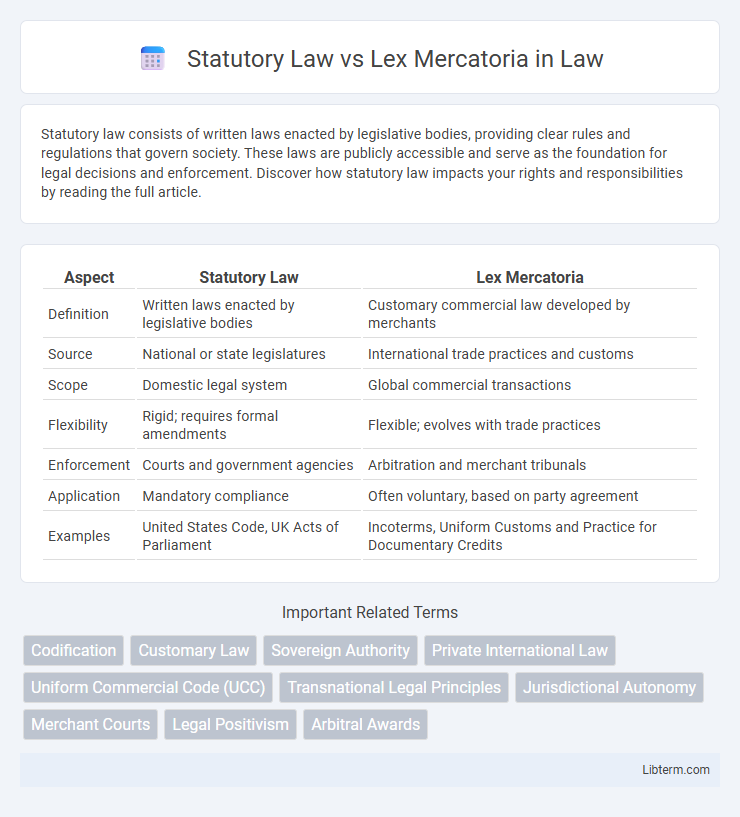Statutory law consists of written laws enacted by legislative bodies, providing clear rules and regulations that govern society. These laws are publicly accessible and serve as the foundation for legal decisions and enforcement. Discover how statutory law impacts your rights and responsibilities by reading the full article.
Table of Comparison
| Aspect | Statutory Law | Lex Mercatoria |
|---|---|---|
| Definition | Written laws enacted by legislative bodies | Customary commercial law developed by merchants |
| Source | National or state legislatures | International trade practices and customs |
| Scope | Domestic legal system | Global commercial transactions |
| Flexibility | Rigid; requires formal amendments | Flexible; evolves with trade practices |
| Enforcement | Courts and government agencies | Arbitration and merchant tribunals |
| Application | Mandatory compliance | Often voluntary, based on party agreement |
| Examples | United States Code, UK Acts of Parliament | Incoterms, Uniform Customs and Practice for Documentary Credits |
Introduction to Statutory Law and Lex Mercatoria
Statutory law consists of codified statutes and regulations enacted by governmental legislative bodies, providing a formal legal framework that governs conduct within jurisdictions. Lex Mercatoria, or the "law merchant," represents a body of customary commercial principles developed by merchants over centuries to facilitate international trade with flexible, universally accepted rules. Understanding the interplay between statutory law and lex mercatoria is essential for navigating disputes and contracts in cross-border commercial transactions.
Historical Development of Statutory Law
Statutory law emerged from codified systems established by states to provide clear, consistent legal frameworks, with roots tracing back to ancient civilizations such as Babylonian and Roman law. Its historical development involved the gradual replacement of customary and feudal laws with formal legislative enactments during the Middle Ages and the rise of nation-states. This evolution enabled centralized authority to create uniform legal codes, contrasting with the flexible, practice-based norms of Lex Mercatoria used in transnational commercial trade.
Origins and Evolution of Lex Mercatoria
Lex Mercatoria, rooted in medieval European trade practices, evolved as a customary body of commercial law created by merchants to resolve disputes across borders during the absence of uniform statutory regulations. Unlike statutory law, which is codified and enacted by sovereign authorities, Lex Mercatoria originated from informal agreements and practices aligned with the dynamic needs of international commerce. Over time, it has influenced modern transnational commercial law by providing flexible, trader-based principles supplementing formal legal frameworks.
Key Features of Statutory Law
Statutory law consists of formally enacted legislation passed by a legislative body, providing clear, written rules that are binding and enforceable by courts. It features codification, predictability, and specificity, ensuring uniform application of legal standards within a jurisdiction. Statutory law differs from lex mercatoria by being state-sanctioned, whereas lex mercatoria comprises customary rules developed by merchants across borders for international trade.
Core Principles of Lex Mercatoria
Lex Mercatoria, often referred to as the "law merchant," is a body of commercial principles and customs developed by merchants across different jurisdictions, emphasizing flexibility, fairness, and international applicability in trade disputes. Core principles include party autonomy, good faith, and the enforcement of customary trade usages, which contrast with the rigid, codified rules of statutory law that are enacted by governmental authorities. This framework aims to facilitate cross-border commerce by providing a uniform set of rules that transcend national legal systems, promoting efficiency and predictability in international transactions.
Differences in Application: Statutory Law vs Lex Mercatoria
Statutory law is enacted by governmental legislative bodies and applies within prescribed jurisdictions, providing clear, codified rules enforceable by state courts. Lex mercatoria, or the law merchant, comprises customary commercial principles developed by merchants over time and often applies in international trade disputes where parties seek neutral, flexible solutions beyond national statutes. Unlike statutory law's rigid framework, lex mercatoria emphasizes party autonomy and adaptability, allowing enforcement through arbitration rather than traditional court systems.
Role in International Commercial Transactions
Statutory law provides a formal legal framework established by national governments regulating international commercial transactions with clear rules and enforceable obligations. Lex Mercatoria, or the "law merchant," operates as a body of customary commercial principles and practices developed by international traders, offering flexibility and adaptability in cross-border agreements. In international commercial transactions, statutory law ensures legal certainty through codified statutes, while Lex Mercatoria fills gaps by promoting uniformity and resolving disputes through trade usage and arbitration.
Advantages and Limitations of Statutory Law
Statutory law provides clear, codified rules that ensure legal certainty and predictability for businesses, facilitating consistent application and enforcement within jurisdictions. Its advantages include formal legitimacy, accessibility, and the capacity for systematic amendment to address evolving societal needs. Limitations of statutory law involve rigidity, jurisdictional boundaries, and slower adaptation to dynamic commercial practices compared to the flexible, transnational nature of lex mercatoria.
Benefits and Challenges of Lex Mercatoria
Lex Mercatoria offers the benefit of flexible, internationally recognized rules that facilitate cross-border trade by reducing reliance on divergent national statutory laws. Its adaptability allows parties to tailor agreements according to commercial customs and practices, promoting efficiency and predictability in global transactions. Challenges include limited formal enforcement mechanisms and potential conflicts with domestic legal systems, which can create uncertainty and complicate dispute resolution.
The Future Interplay: Statutory Law and Lex Mercatoria in Modern Commerce
The future interplay between statutory law and lex mercatoria in modern commerce highlights a dynamic balance where codified national regulations coexist with evolving customary commercial practices. Statutory law provides a stable legal framework ensuring enforceability and predictability, while lex mercatoria offers flexibility and adaptability to cross-border trade complexities. Emerging trends indicate increased integration through harmonization efforts like the United Nations Convention on Contracts for the International Sale of Goods (CISG), fostering a global legal environment that supports both formal legislation and informal commercial norms.
Statutory Law Infographic

 libterm.com
libterm.com